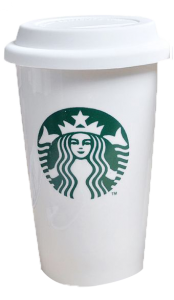Q. I have a first-world problem that is probably very common for a lot of busy professionals in this day and age: I sometimes get so caught up with work that I forget to drink my quad vanilla soy latte before it gets cold. Is it safe for me to warm it back up by zapping it in the microwave? Like, can you microwave Starbucks cups? Also, what about iced drinks? Can I use the microwave to turn them into a hot drink if I change my mind after the fact?

A. You are going to want to think twice before you put a Starbucks cup anywhere near a microwave! While their ubiquitous paper cups may seem perfectly harmless, there are several reasons why they should not be reheated. Meanwhile, the iced cups are even more questionable, particularly since these transparent vessels were not designed for high temperatures in the first place.
So, why would it be hazardous to put the iconic Starbucks cup in your microwave? The answer is polyethylene. Most coffee drinkers will be surprised to learn that their daily beverage containers are covertly lined with this oil-based plastic coating, which is designed to maintain warmth and safety by providing additional insulation. It is worth remembering that nothing at Starbucks is served over 200°F, which is far lower than the temperature of an average microwave, and it is also just slightly below the level of heat that would be able to degrade this lining.
Unfortunately, the interior plastic will dissolve in response to any form of heat radiation including common microwaves. The melting resin can subsequently seep into your drink, which is not only gross and unappetizing, but it may have harmful health effects as well. Although polyethylene is safe for the product’s intended use, it has been proven to release a poisonous metalloid called antimony. The presence of this toxin can cause ulcers, diarrhea, nausea and vomiting. The scariest thing is that the naked eye cannot even detect the appearance of antimony dissolving into their peppermint mocha or medicine ball.
While some plastics are specifically formulated and engineered to be microwave safe, these designs are more expensive and usually intended for long-term reusability. Thus, the varieties of plastic seen in high-speed food industries like Starbucks are assuredly not safe for reheating. In fact, the company has struggled to find methods for even recycling their paper cups, and polyethylene is the culprit once more. If a multi-billion-dollar corporation cannot conjure the technology to salvage and reuse their cups, then they obviously haven’t even broached the topic of microwave safety yet.
With these facts established, we have to rule against microwaving disposable hot cups from Starbucks. This isn’t just our opinion; in fact, this is the company’s own standpoint too. For over a decade, they have been subtly adding fine print to every short, tall, grande and venti. It clearly and unmistakably declares, “Do Not Microwave.” That says it all right there! Other major brands that use polyethylene in their cups abide by the same policy. This includes McDonalds and Dunkin’ Donuts.
In the end, it’s wise to simply transfer your coffee to a microwave-safe mug and warm up it in that instead. Unless you like bubbly plastic ooze with your caffeine, keep that Starbucks cup in the cold! The protective oil will end up getting more cooked than CEO Howard Schultz’s presidential ambitions, but I digress. It’s just a contaminant that will do more harm than good in that heated of a setting.
Anyways, let’s answer your other question: What about the iced cups? First off, I’m not sure why anyone would want to warm up their vanilla sweet cream cold brew with three pumps of caramel, but that’s a topic for another day. Anyways, according to logic, these cups would be even more dangerous to zap than their hot counterparts. If a partial dose of plastic is already problematic, then the pure plastic version is going to be much worse. An iced cup is likely to warp and mutate before your eyes if you put it in the microwave, and it could make a nasty mess if left unattended for more than a few seconds. To tell the truth, I speak from experience as both a former barista and an avid microwave user. Just don’t do it!
So, as an addendum, can you microwave Starbucks cups that were purchased as merchandise? The answer here is: It depends on the cup itself. Because the company has literally produced thousands of distinct drink containers, it is impossible to issue a blanket declaration for all of them. However, it is generally safe to assume that the plastic products might not be microwave safe. Most of the ceramic mugs and thermoses are okay to reheat, but I’ve encountered some holiday glasses that sparked in the microwave because of subtle gold-leaf detailing.
Maybe someday Starbucks will uncover the perfect recipe for a microwavable cup, but we are not in that utopian era yet. For now, it is best to err on the side of caution and avoid microwaving any Starbucks containers. While the urge for a quick fix might seem overwhelming, the extra step of transferring the fluid takes only a few seconds. This preliminary safeguard requires minimal effort and will stave off the potential of tremendous stomach complications.
As a side note, it sounds like your drinks are cooling off a bit too rapidly! I recommend ordering them extra hot to ensure their warmth outlasts a naturally fleeting attention span. I’ve found this clever tactic renders the whole “can you microwave Starbucks cups” topic completely moot. A couple extra degrees up front makes all the difference in still having a tasty espresso later in the day! If you do find the need to reheat your coffee, simply make sure to have a spare mug on hand just in case.